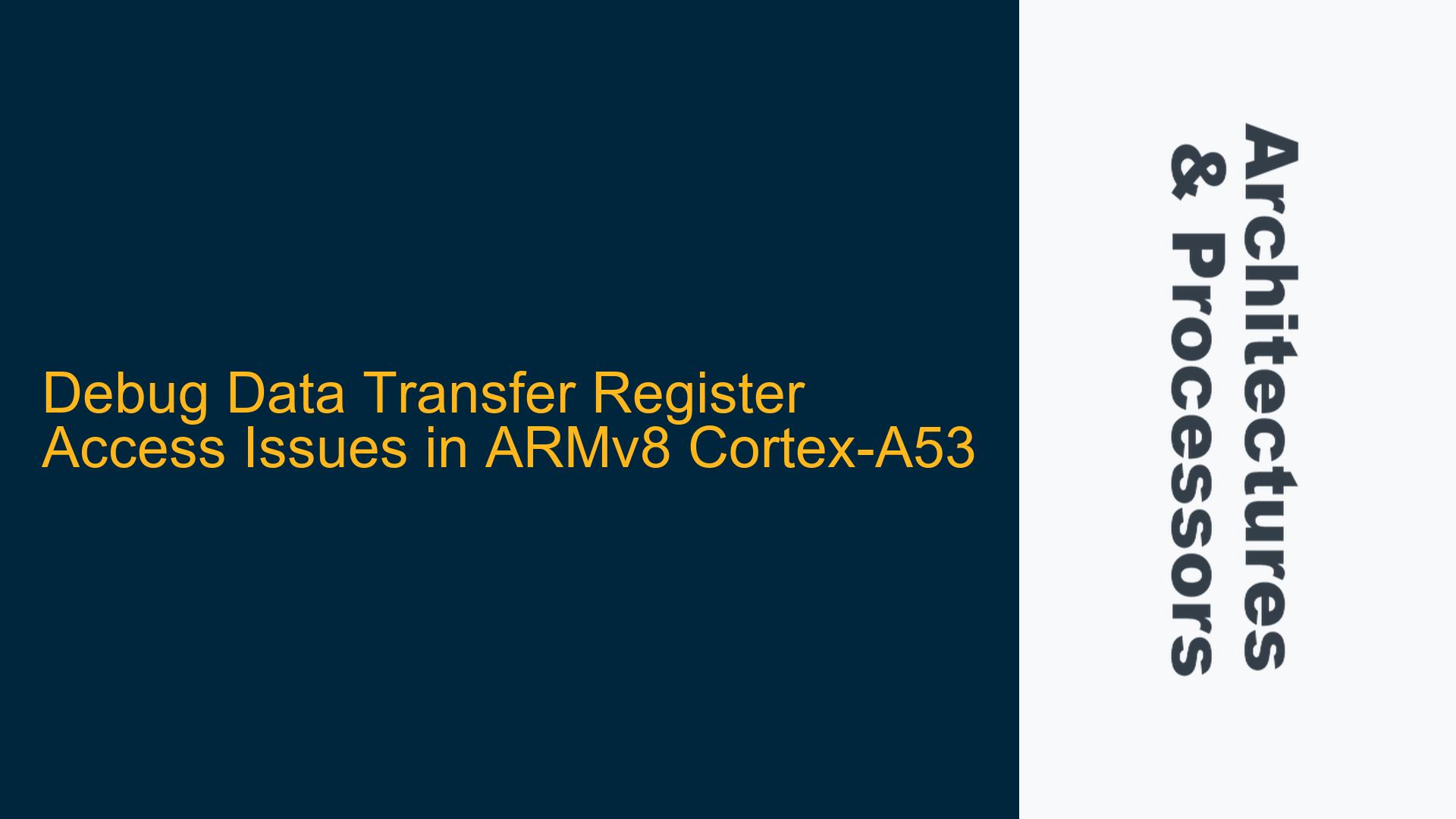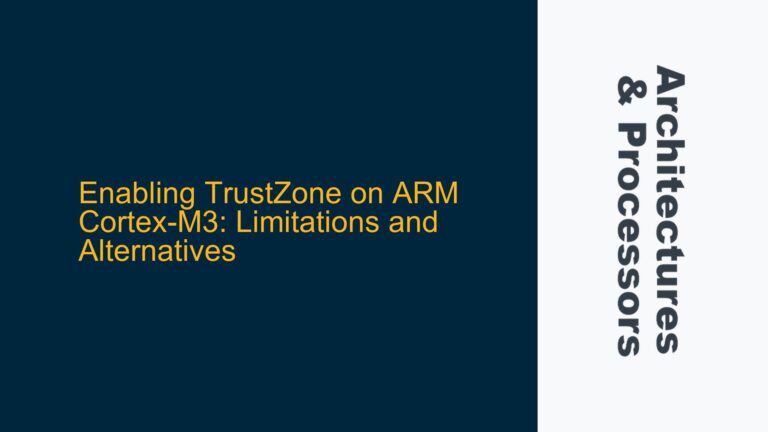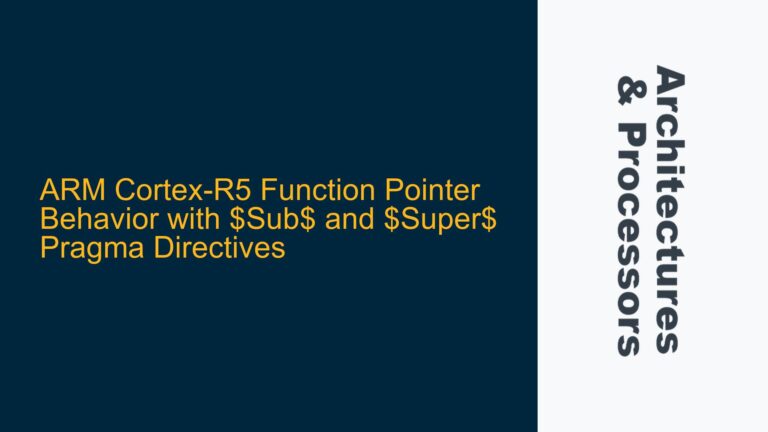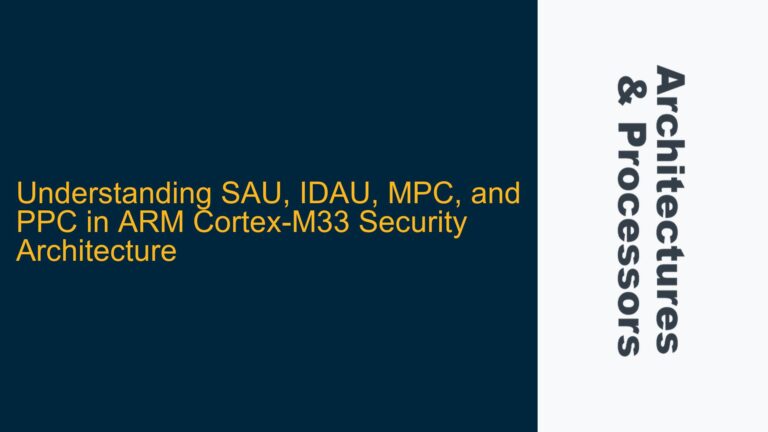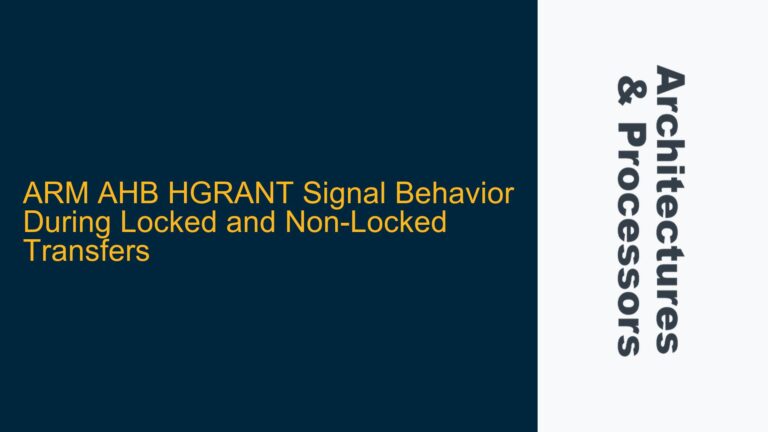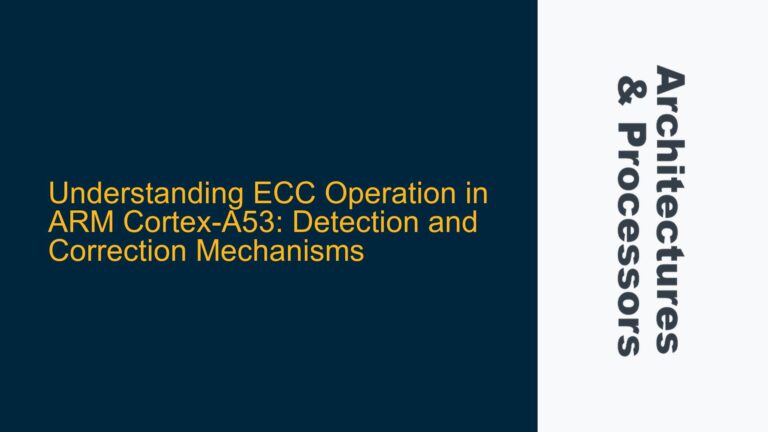ARMv8 Cortex-A53 Debug Data Transfer Register (DBGDTRTX_EL0) Access Challenges
The Debug Data Transfer Register (DBGDTRTX_EL0) in ARMv8 architectures, particularly in the Cortex-A53 processor, is a critical component for debugging operations. It allows developers to transfer data between the processor and external debug tools. However, accessing this register can be fraught with challenges, especially when attempting to write and read values to and from it. The primary issue arises when developers attempt to write a value to a general-purpose register (e.g., X3) and then transfer that value to the DBGDTRTX_EL0 register, only to find that the expected data is not reflected in the debug register. This issue is often compounded by misunderstandings of the ARMv8 architecture, particularly the role of memory barriers and the state of the MDCCSR_EL0.TXfull flag.
The Cortex-A53 processor, being part of the ARMv8-A architecture, implements a sophisticated debugging mechanism that includes several control and status registers. The DBGDTRTX_EL0 register is used to transmit data from the processor to an external debugger, while the DBGDTRRX_EL0 register is used for receiving data. The process of writing to and reading from these registers is not as straightforward as it might seem, primarily due to the need for proper synchronization and the handling of the TXfull flag in the MDCCSR_EL0 register.
Missing Memory Barriers and Incorrect Polling of MDCCSR_EL0.TXfull
One of the most common causes of issues when accessing the DBGDTRTX_EL0 register is the omission of memory barriers and incorrect handling of the MDCCSR_EL0.TXfull flag. The MDCCSR_EL0 register, which is an alias of the EDSCR register, contains the TXfull flag that indicates whether the DBGDTRTX_EL0 register is ready to accept new data. If this flag is not properly polled before and after writing to the DBGDTRTX_EL0 register, the data transfer may fail silently, leading to unexpected results.
The ARMv8 architecture requires explicit synchronization when dealing with debug registers. This is because the processor may reorder instructions or delay writes to improve performance, which can lead to race conditions when accessing debug registers. Memory barriers such as ISB (Instruction Synchronization Barrier) and DSB (Data Synchronization Barrier) are essential to ensure that the processor completes all pending operations before proceeding to the next instruction. Without these barriers, the write to the DBGDTRTX_EL0 register may not be completed before the subsequent read operation, leading to incorrect data being read.
Another potential cause of the issue is the incorrect assumption that the DBGDTRTX_EL0 register can be accessed in the same way as general-purpose registers. The debug registers have specific access requirements and constraints that must be adhered to. For example, the DBGDTRTX_EL0 register can only be written to when the TXfull flag in the MDCCSR_EL0 register is clear. If this condition is not met, the write operation will not take effect, and the data will not be transferred to the external debugger.
Implementing Proper Synchronization and Polling Mechanisms for DBGDTRTX_EL0 Access
To resolve the issues related to accessing the DBGDTRTX_EL0 register, developers must implement proper synchronization and polling mechanisms. The following steps outline a robust approach to writing and reading from the DBGDTRTX_EL0 register:
First, before attempting to write to the DBGDTRTX_EL0 register, it is essential to poll the MDCCSR_EL0.TXfull flag to ensure that the register is ready to accept new data. This can be done by reading the MDCCSR_EL0 register and checking the state of the TXfull flag. If the flag is set, it indicates that the DBGDTRTX_EL0 register is still holding previous data and is not ready for a new write. The processor should wait until the TXfull flag is cleared before proceeding with the write operation.
Once the TXfull flag is cleared, the developer can proceed to write the desired value to the DBGDTRTX_EL0 register. This is typically done using the MSR (Move to System Register) instruction, which transfers the value from a general-purpose register (e.g., X3) to the DBGDTRTX_EL0 register. After the write operation, an ISB (Instruction Synchronization Barrier) should be executed to ensure that the write to the DBGDTRTX_EL0 register is completed before any subsequent operations.
Following the ISB, the developer should again poll the MDCCSR_EL0.TXfull flag to confirm that the write operation was successful. If the TXfull flag is set, it indicates that the data has been successfully transferred to the DBGDTRTX_EL0 register and is ready to be read by the external debugger. At this point, a DSB (Data Synchronization Barrier) should be executed to ensure that all memory operations are completed before proceeding to the next instruction.
Finally, the developer can read the value from the memory-mapped debug register at the appropriate offset (e.g., 0x08C) to verify that the data has been correctly transferred. It is important to note that the memory-mapped debug registers may have different access requirements compared to the system registers, and developers should consult the processor’s technical reference manual for specific details.
In summary, accessing the DBGDTRTX_EL0 register in the ARMv8 Cortex-A53 processor requires careful attention to synchronization and polling mechanisms. By ensuring that the MDCCSR_EL0.TXfull flag is properly polled and that memory barriers are correctly implemented, developers can avoid common pitfalls and achieve reliable data transfer between the processor and external debug tools.
Detailed Explanation of Memory Barriers and Their Role in Debug Register Access
Memory barriers play a crucial role in ensuring the correct operation of debug registers in ARMv8 architectures. The ARMv8 architecture allows for out-of-order execution and speculative execution, which can lead to race conditions when accessing system registers such as DBGDTRTX_EL0. Memory barriers are used to enforce ordering constraints on memory operations, ensuring that all previous operations are completed before proceeding to the next instruction.
The ISB (Instruction Synchronization Barrier) is used to ensure that all previous instructions are completed before any subsequent instructions are executed. This is particularly important when writing to system registers, as it ensures that the write operation is completed before any subsequent read operations. In the context of accessing the DBGDTRTX_EL0 register, the ISB ensures that the write to the register is completed before the processor attempts to read the value from the memory-mapped debug register.
The DSB (Data Synchronization Barrier) is used to ensure that all previous memory operations are completed before any subsequent memory operations are executed. This is important when reading from memory-mapped debug registers, as it ensures that the read operation is performed on the most up-to-date data. In the context of accessing the DBGDTRTX_EL0 register, the DSB ensures that the data transferred to the register is correctly reflected in the memory-mapped debug register before it is read by the external debugger.
In addition to memory barriers, developers must also be aware of the role of the MDCCSR_EL0.TXfull flag in the data transfer process. The TXfull flag indicates whether the DBGDTRTX_EL0 register is ready to accept new data. If the flag is set, it indicates that the register is still holding previous data and is not ready for a new write. Developers must poll this flag before and after writing to the DBGDTRTX_EL0 register to ensure that the data transfer is successful.
Practical Example: Writing and Reading from DBGDTRTX_EL0 in Cortex-A53
To illustrate the correct process of writing and reading from the DBGDTRTX_EL0 register, consider the following example:
-
Poll MDCCSR_EL0.TXfull: Before writing to the DBGDTRTX_EL0 register, the developer must first poll the MDCCSR_EL0.TXfull flag to ensure that the register is ready to accept new data. This can be done using a loop that continuously reads the MDCCSR_EL0 register and checks the state of the TXfull flag. The loop should exit when the TXfull flag is cleared, indicating that the DBGDTRTX_EL0 register is ready for a new write.
-
Write to DBGDTRTX_EL0: Once the TXfull flag is cleared, the developer can proceed to write the desired value to the DBGDTRTX_EL0 register. This is typically done using the MSR instruction, which transfers the value from a general-purpose register (e.g., X3) to the DBGDTRTX_EL0 register. For example, the following instruction writes the value 0x100000000 to the DBGDTRTX_EL0 register:
MOV X3, #0x100000000 MSR DBGDTRTX_EL0, X3 -
Execute ISB: After writing to the DBGDTRTX_EL0 register, the developer should execute an ISB to ensure that the write operation is completed before any subsequent operations. The ISB ensures that the processor completes all pending instructions before proceeding to the next instruction.
-
Poll MDCCSR_EL0.TXfull: Following the ISB, the developer should again poll the MDCCSR_EL0.TXfull flag to confirm that the write operation was successful. If the TXfull flag is set, it indicates that the data has been successfully transferred to the DBGDTRTX_EL0 register and is ready to be read by the external debugger.
-
Execute DSB: After confirming that the TXfull flag is set, the developer should execute a DSB to ensure that all memory operations are completed before proceeding to the next instruction. The DSB ensures that the data transferred to the DBGDTRTX_EL0 register is correctly reflected in the memory-mapped debug register before it is read by the external debugger.
-
Read from Memory-Mapped Debug Register: Finally, the developer can read the value from the memory-mapped debug register at the appropriate offset (e.g., 0x08C) to verify that the data has been correctly transferred. The read operation should return the value 0x100000000, confirming that the data transfer was successful.
By following these steps, developers can ensure that the data transfer between the processor and the external debugger is performed correctly and reliably. The use of memory barriers and proper polling of the MDCCSR_EL0.TXfull flag are essential to avoid common pitfalls and achieve successful debug operations.
Conclusion
Accessing the DBGDTRTX_EL0 register in the ARMv8 Cortex-A53 processor requires a thorough understanding of the ARMv8 architecture, particularly the role of memory barriers and the state of the MDCCSR_EL0.TXfull flag. By implementing proper synchronization and polling mechanisms, developers can avoid common issues and achieve reliable data transfer between the processor and external debug tools. The use of ISB and DSB memory barriers, along with careful polling of the TXfull flag, ensures that the data transfer is performed correctly and that the expected data is reflected in the debug registers. This approach is essential for successful debugging operations in ARMv8 architectures.
